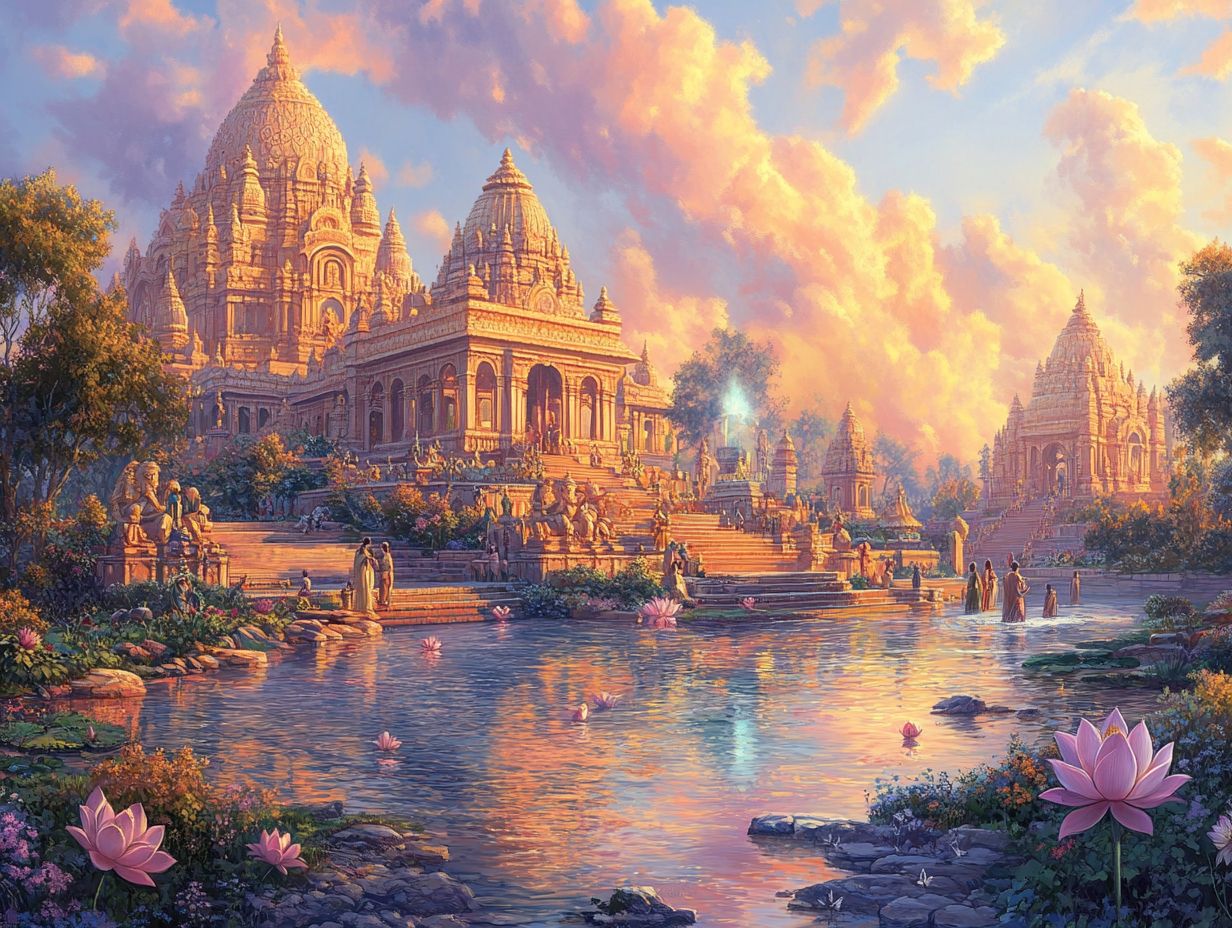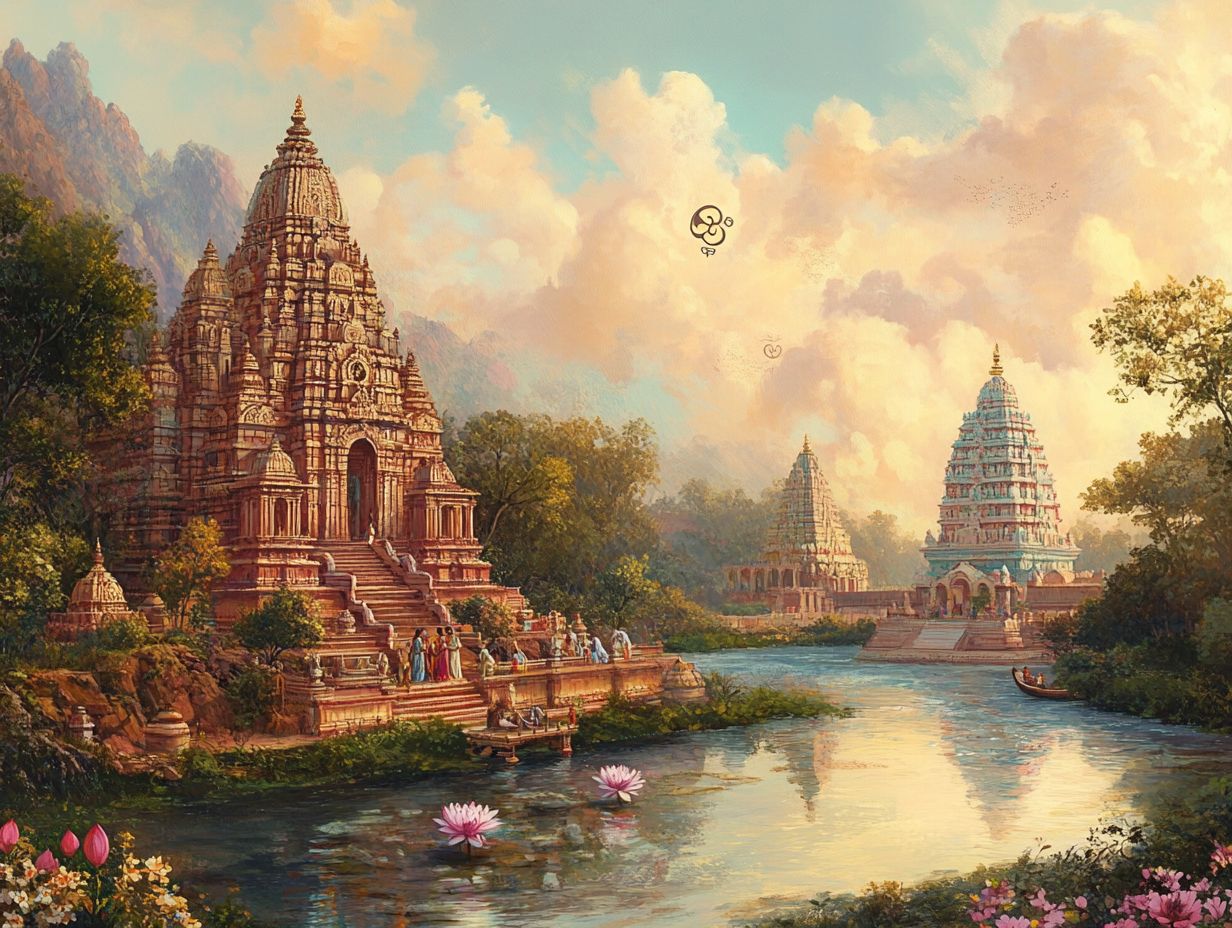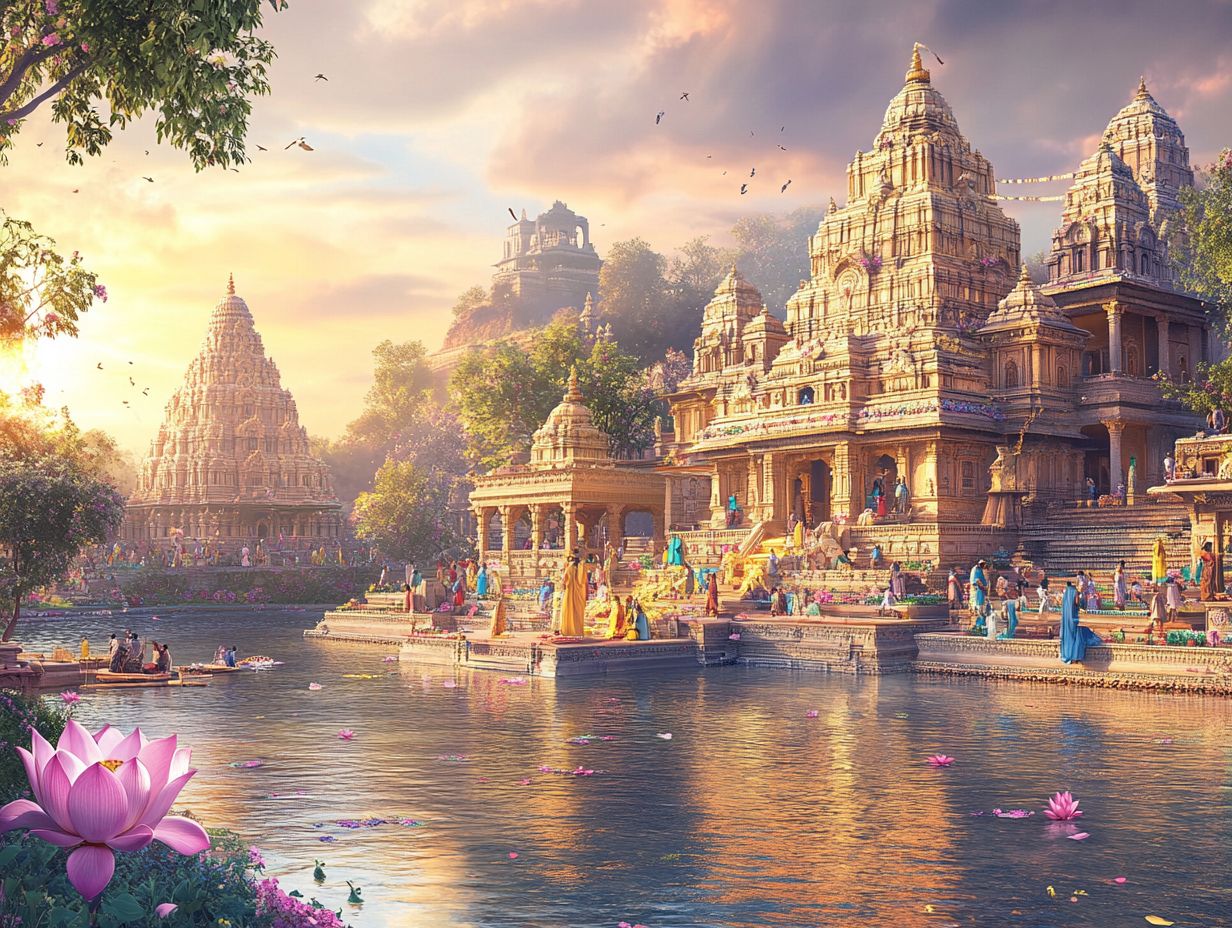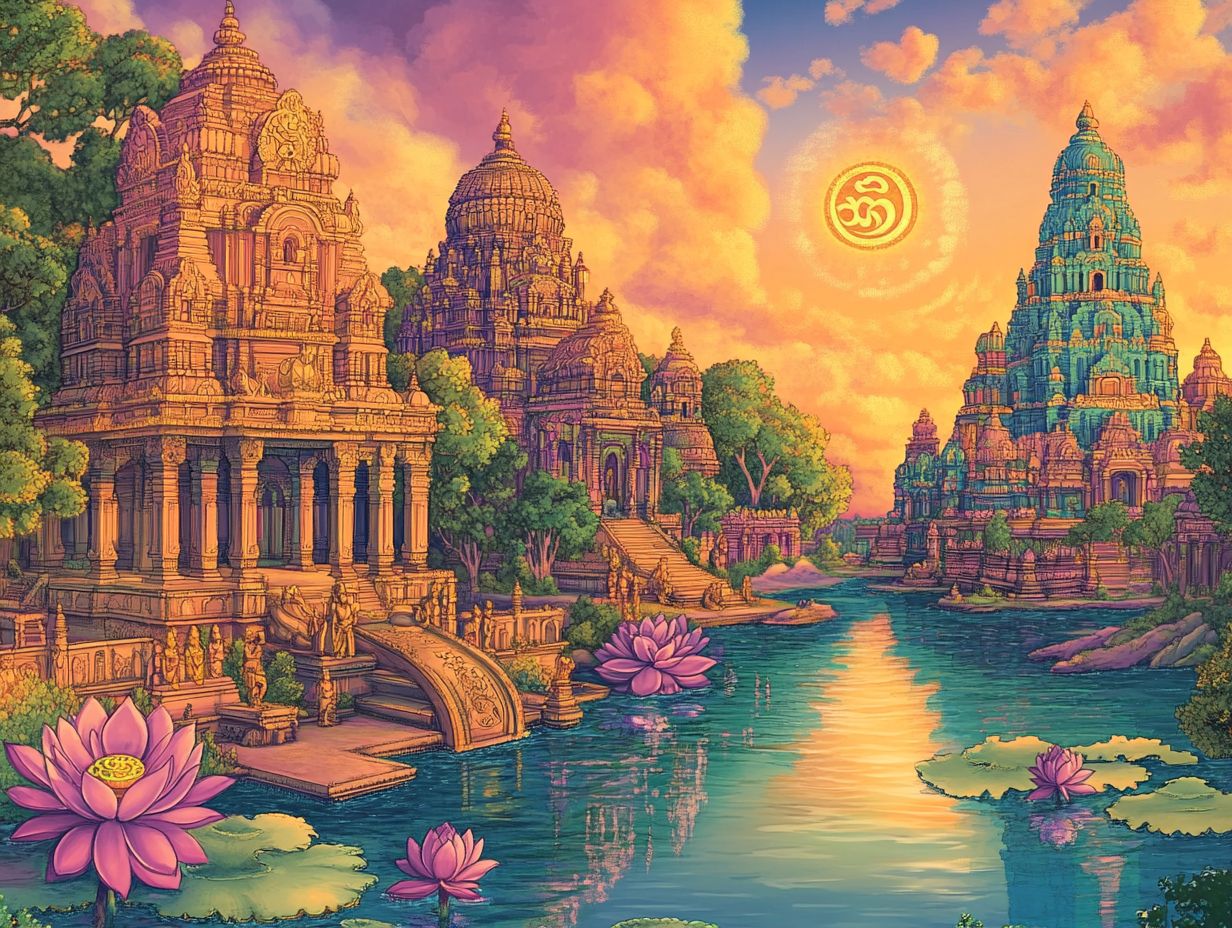How Did Hinduism Emerge in South Asia?
Hinduism, renowned as one of the world’s oldest religions, boasts a rich and intricate history that can be traced back to ancient civilizations, including the Indus Valley Civilization, and a myriad of cultural influences, such as indigenous beliefs and migration patterns.
From its origins in the early days of the Indus Valley Civilization to the significant impacts of Buddhism, Jainism, and indigenous rituals, the evolution of Hinduism into a distinct faith carries profound historical weight.
One can observe how various Hindu dynasties have played a pivotal role in shaping its development, facilitating its expansion beyond the borders of South Asia and influencing socio-political dynamics.
Additionally, contemporary challenges, including globalization and environmentalism in Hinduism, are currently influencing the practice of Hinduism in the modern era. The exploration of Hinduism reveals not only its enduring legacy but also its potential future within an increasingly globalized world.
The Early History of Hinduism

Hinduism, recognized as one of the world’s oldest religions, traces its origins to the ancient civilization of the Indus Valley, where early religious practices began to take root, shaped by a multitude of cultural and social influences.
This intricate tapestry of beliefs underwent significant evolution with the arrival of the Aryans, who introduced the Vedic texts that formed the cornerstone of Hindu philosophy. These texts encompassed a diverse array of rituals and spiritual practices that would define the religion for centuries.
Central to this transformation was the cultural synthesis that unfolded over time, resulting in a distinctive amalgamation of traditions and beliefs that ultimately shaped the Hinduism we recognize today.
The Indus Valley Civilization and the Vedic Period
The Indus Valley Civilization, flourishing around 2500 BCE, stands as one of the earliest urban cultures, distinguished by its advanced societal structures and enigmatic religious practices that provide tantalizing glimpses into the nascent foundations of Hinduism.
The subsequent Vedic period, commencing around 1500 BCE, heralded a profound transformation in religious thought, marked by the emergence of the Vedic texts written in Sanskrit.
Recent archaeological excavations at sites such as Mohenjo-Daro and Harappa have revealed a wealth of seals and symbols, including depictions of mythical creatures and motifs suggestive of deities, which offer valuable insights into the spiritual life of these early inhabitants.
The transition to the Vedic period witnessed a remarkable assimilation of cultural elements, as the arrival of the Indo-Aryans introduced fresh rituals and philosophies, encapsulated in the Vedic texts, that gradually intermingled with pre-existing beliefs.
This synthesis set the stage for the development of intricate Vedic rituals, which emphasized sacrifice and the recitation of mantras, while simultaneously laying the foundations for later philosophical inquiries that would significantly influence the trajectory of spiritual thought in the region.
The Emergence of Hinduism as a Religion
The emergence of Hinduism as a distinct religion can be traced to the synthesis of various beliefs and practices, particularly those rooted in Brahmanism. This foundation centered around sacred texts such as the Upanishads and the epic narratives found in Hindu mythology, including the Mahabharata and the Ramayana, underscoring the dynamic cultural interactions that characterized ancient South Asia.
This transformation was not a mere linear evolution; rather, it constituted a rich tapestry interwoven with diverse philosophical concepts, rituals, and deities that collectively shaped the spiritual landscape of the region. Influences from local tribal customs, Persian cultural elements, and even Buddhist ideologies contributed to this multifaceted identity, emphasizing the syncretic traditions that emerged over time.
As the sacred texts evolved, they mirrored the changing values and practices of society, illustrating how mythology played a pivotal role in conveying moral lessons and addressing existential questions, while incorporating elements of oral tradition and philosophical inquiry.
Ultimately, this cultural synthesis enabled Hinduism to embrace pluralism, offering a multitude of pathways for individuals in pursuit of spiritual fulfillment and understanding.
The Influence of Buddhism and Jainism
The impact of Buddhism and Jainism on Hinduism is significant, as both religions arose in South Asia around the 6th century BCE. They promoted spiritual practices that questioned established norms and inspired their followers to pursue enlightenment and truth.
Principles such as Ahimsa, or non-violence, found a deep resonance within Hindu philosophy, shaping its ethical framework and spiritual aspirations.
The Impact of Buddhism on Hinduism
Buddhism’s influence on Hinduism manifests through a rich cross-pollination of ideas and practices, as both religions converge around foundational beliefs in karma and Samsara. The emergence of various philosophical schools within Hinduism illustrates a synthesis of Buddhist thought, particularly in relation to meditation and spiritual practices.
This intellectual exchange facilitated the incorporation of meditation techniques that emphasize mindfulness and insight, thereby enriching the spiritual landscape of Hinduism. The ethical principles championed by Buddhism, such as compassion and non-violence, resonated deeply within Hindu moral philosophy, prompting adherents to embrace a more inclusive worldview.
Additionally, the community-oriented aspects of Buddhism introduced the concept of Sangha, which fostered collective spiritual practices. This influence contributed to the formation of various Hindu sects, such as Vaishnavism, Shaivism, and Shaktism, that prioritize communal worship and shared rituals.
Such cultural and philosophical dialogues not only enhanced individual spiritual journeys but also paved the way for a more diversified understanding of divinity and religious pluralism within the Hindu tradition.
The Influence of Jainism on Hinduism
Jainism has played a pivotal role in shaping Hinduism, particularly through the introduction of rigorous ethical practices, most notably the principle of Ahimsa, which champions non-violence toward all living beings. This principle has become a cornerstone of the moral framework that guides many Hindus today.
The foundational belief in harmony and respect for all forms of life resonates profoundly within Hindu rituals, which emphasize compassion and care. The incorporation of Ahimsa into daily practices has inspired numerous Hindus to embrace vegetarian diets and promote environmental consciousness.
Furthermore, the Jain emphasis on community worship and collective spiritual endeavors has influenced the formation of communal gatherings in Hinduism, fostering a sense of unity and shared purpose. Over time, these elements have enriched Hindu rituals, encouraging a more inclusive approach to spirituality that celebrates diversity and inspires adherents to embody ethical principles in their everyday lives.
The Development of Hinduism in South Asia

The evolution of Hinduism in South Asia has unfolded as a dynamically narrative marked by the establishment of temples as pivotal centers of worship, the exuberance of vibrant festivals, and the seamless integration of diverse cultural practices that encapsulate the region’s rich heritage and cultural continuity.
This intricate interplay of elements has culminated in a profound tapestry of beliefs and rituals, reflecting the multifaceted nature of Hinduism and its enduring significance in the cultural landscape of South Asia.
The Rise of Hindu Dynasties
The ascent of Hindu dynasties in South Asia was pivotal in shaping the political landscape and fostering cultural assimilation. These dynasties often served as patrons of the arts, temple construction, and religious scholarship, significantly amplifying the influence of Hinduism throughout the region, particularly through the patronage of sacred sites and pilgrimage.
Take the Chola dynasty, for instance; it played a vital role in promoting Tamil culture and literature, while simultaneously erecting breathtaking temples that functioned as both places of worship and community hubs. Similarly, the Gupta Empire is frequently heralded as the Golden Age of India, renowned for its remarkable advancements in science, mathematics, and art, all of which were deeply intertwined with Hindu philosophies and temple architecture.
These dynastic rulers understood that enhancing religious practices and cultural initiatives not only solidified their own legitimacy but also unified diverse populations under a cohesive spiritual framework. By intertwining governance with the promotion of Hindu values and beliefs, these dynasties cultivated an environment where spirituality thrived, becoming an integral part of daily life and influencing everything from festivals to philosophical discourse and rituals of worship.
The Role of Hinduism in Indian Society
Hinduism plays a multi-faceted role in Indian society, serving not only as a spiritual framework but also as a guiding force in social structure, community worship, and individual identity. It shapes the values and practices of millions across India’s diverse landscape, influencing both rural and urban Hinduism.
The teachings of Hinduism deeply infiltrate the social norms that govern everyday life, influencing everything from interpersonal relationships to communal responsibilities. The caste system, although often a contentious issue, continues to resonate within various layers of society, affecting how individuals interact based on their perceived social standing. Notably, the concept of dharma, which outlines duties and ethics, plays a crucial role in maintaining social harmony.
The concept of dharma, which encapsulates an individual’s duty and righteousness, is pivotal in maintaining societal order and cohesion. Moreover, Hindu festivals, with their vibrant celebrations and rituals, cultivate a sense of community identity, uniting people in both spiritual and cultural expressions that reinforce shared beliefs and ancestral beliefs.
These dynamics reveal that the principles of Hinduism significantly shape the societal fabric, illustrating a profound connection between faith and community life, as well as between philosophy and cultural synthesis.
The Spread of Hinduism Beyond South Asia
The expansion of Hinduism beyond South Asia has been driven by a multitude of channels, including trade, migration, and the Indian diaspora. This movement has led to the establishment of vibrant Hindu communities across Southeast Asia and various regions worldwide, reflecting the religion’s historical development and philosophical diversity.
As a result, there has been a rich intercultural exchange, allowing Hindu practices to adapt and flourish within diverse local contexts, showcasing the religion’s ability to undergo religious reform while maintaining cultural heritage.
Hinduism in Southeast Asia
Hinduism’s influence in Southeast Asia is characterized by a remarkable process of cultural assimilation and the creation of iconic temples, with Angkor Wat in Cambodia standing as a prime symbol of the enduring impact of Hindu beliefs and practices in the region. This monumental site, along with the celebration of festivals that weave together local traditions and Hindu rituals, highlights the deep-rooted connections between the two, and reflects the syncretic traditions that have emerged.
These sacred sites are not merely architectural wonders; they serve as a testament to the historical interactions between diverse cultures. In Indonesia, the resplendent Prambanan temple complex presents stunning reliefs that vividly depict Hindu epics, such as the Mahabharata and Ramayana, while Thailand’s revered Wat Phra Kaew functions as a central hub of worship.
Throughout the year, a variety of festivals infused with Hindu elements come to life, exemplifying this rich cultural tapestry. The vibrant Diwali celebrations in Bali, for instance, showcase the local Hindu community embracing their heritage while honoring traditional Balinese customs. Such festivals underscore how Hinduism not only persists but flourishes, continually enriching local cultures with its timeless traditions and spiritual practices.
Hinduism in Other Parts of the World
Hinduism has captivated a global audience, particularly through the Indian diaspora, which boasts significant communities in nations such as the United States, Canada, and the United Kingdom. In these regions, cultural exchanges have fostered adaptations of traditional practices, leading to the establishment of vibrant Hindu temples and lively festivals.
These communities often weave their ancient customs into the fabric of contemporary local cultures, creating a unique tapestry of beliefs and practices that honor both their heritage and their newfound environments. As they adapt to modernity, many members encounter challenges, particularly in the assimilation of younger generations who may struggle to connect with traditional customs and philosophical schools.
Nonetheless, they engage in creative expressions of their faith through art, music, and community activities, ensuring that their core values and rituals are preserved. The evolution of contemporary Hindu practices within the diaspora exemplifies a remarkable blend of resilience and innovation, reflecting their ongoing efforts to maintain cultural identity while navigating life in diverse societies, and engaging in interfaith dialogue.
The Modern Day Practice of Hinduism

In contemporary society, Hinduism has entered a dynamic phase of evolution, seamlessly integrating modern practices, adapting rituals, and celebrating festivals that resonate with the complexities of a globalized world. The integration of yoga and meditation into daily routines exemplifies this evolution.
Yet, it remains steadfast in preserving the core values and beliefs that have endured for thousands of years.
Hinduism in Contemporary South Asia
In contemporary South Asia, Hinduism stands as a formidable force, significantly shaping rituals, social structures, and the observance of religious festivals that hold immense importance for millions. This vibrant faith reflects a harmonious blend of tradition and modernity, creating a rich tapestry of cultural expression influenced by both Indus Valley Civilization and Vedic texts.
The practices of Hinduism not only uphold age-old values but also demonstrate remarkable adaptability to the evolving societal landscape, illustrating the resilience of cultural identity in an increasingly globalized world. Major festivals like Diwali and Holi serve as essential anchors for communities, providing a shared platform for collective celebration that fosters social cohesion.
Moreover, the observance of rites such as weddings and various rites of passage seamlessly intertwines ancient customs with contemporary relevance, bridging generational divides. These practices often encompass elements like karma and samsara. Consequently, the dynamic nature of Hindu practices exemplifies how tradition can be preserved while simultaneously evolving to align with the expectations and realities of modern life.
The Challenges and Controversies Faced by Hinduism Today
Hinduism today encounters a myriad of challenges and controversies, ranging from the impacts of globalization that reshape traditional practices to interfaith dialogues that call into question religious authority and the place of Hinduism within a pluralistic society. The rise of sectarianism also adds to these challenges.
These challenges are exacerbated by the rise of sectarianism and religious intolerance, which pose a significant threat to the social fabric of communities that have coexisted harmoniously for centuries. The younger generation, increasingly swayed by global cultural trends, often finds itself wrestling with identity, striving to strike a balance between contemporary values and ancestral beliefs, as well as between traditional practices and modern influences.
This cultural tug-of-war not only influences individual practices but also prompts essential inquiries regarding the future of rituals, community engagement, and scriptural interpretations. In this context, engaging in constructive dialogue becomes crucial, as it cultivates understanding and encourages reform, ultimately aiding in the navigation of these complexities while preserving the essence of this profound spiritual heritage, including the core concepts of moksha and Brahman.
The Future of Hinduism
The future of Hinduism is primed for adaptation within an increasingly interconnected world. It faces the intricate challenges of religious reform, embraces the influence of technology, and contemplates its significant role in shaping global culture all while endeavoring to preserve its foundational philosophical tenets and practices.
The Growth and Adaptation of Hinduism in the Modern World
Hinduism’s growth and adaptation in the modern world illustrate a dynamic response to cultural diversity and the evolving needs of its followers. It actively embraces new spiritual practices, philosophical inquiries, and community engagement to maintain its relevance, while still honoring ancient traditions and rituals of worship.
The incorporation of yoga and meditation into mainstream wellness routines serves as a prime example of how ancient practices are being reinterpreted to align with contemporary lifestyles that prioritize mental health and physical well-being, as well as holistic health.
Organizations that champion interfaith dialogue embody a commitment to nurturing harmony within diverse societies, enabling practitioners to explore shared values while simultaneously honoring their unique beliefs and engaging in religious tolerance.
Furthermore, the active participation of younger generations in community service initiatives underscores the religion’s strong emphasis on social responsibility, merging traditional principles with modern-day activism, and reflecting elements of bhakti movement and asceticism.
Such adaptations not only reflect the evolving spiritual landscape but also reinforce the resilience of Hinduism as a living tradition, capable of addressing the complexities of today s multifaceted world and preserving its oral tradition.
The Role of Hinduism in Shaping Global Culture
Hinduism significantly shapes global culture, influencing various domains such as spirituality, philosophy, and wellness. Practices like yoga and meditation have gained widespread recognition and have been seamlessly integrated into diverse lifestyles, reflecting the religion’s socio-cultural dynamics and philosophical inquiry.
This influence transcends mere physical exercise; it permeates mental well-being and ethical considerations, fostering discussions around holistic health and personal identity. As individuals around the globe embrace these practices, they often engage in profound reflections on purpose and mindfulness, highlighting the importance of meditation practices.
In numerous cultural contexts, elements of Hindu philosophy such as ahimsa (non-violence) and dharma (duty) are intricately woven into contemporary dialogues regarding ethics and sustainable living. The growing interest in these teachings cultivates a deeper understanding of interconnectedness, transforming perceptions of health to encompass not only individual well-being but also societal responsibility and global consciousness, while promoting environmentalism in Hinduism.
Frequently Asked Questions

What is the history of Hinduism in South Asia?
Hinduism emerged in South Asia around 1500 BCE with the migration of Indo-Aryan tribes from Central Asia. It is believed to have evolved from the ancient Indus Valley Civilization and the Vedic religion, incorporating both indigenous beliefs and Indo-European languages.
How did Hinduism spread in South Asia?
The spread of Hinduism in South Asia involved the cultural synthesis of ancient traditions from various regions, integration of religious practices, and the influence of philosophical schools like Vaishnavism, Shaivism, and Shaktism.
Hinduism spread through the gradual assimilation of local beliefs and customs in South Asia, dating back to the Indus Valley Civilization. It also gained popularity through the spread of the Gupta Empire and the influence of Hindu rulers, as well as trade, missionary activities, and the cultural synthesis of various indigenous beliefs and rituals.
What are the major beliefs and practices of Hinduism in South Asia?
Hinduism in South Asia is based on the belief in multiple deities (polytheism), reincarnation (samsara), and karma. It also emphasizes the importance of dharma (duty), artha (wealth), kama (pleasure), and moksha (liberation). The philosophical inquiry found in Vedic texts and Upanishads shapes its core principles, and practices such as yoga and meditation play a significant role in daily life.
Did Hinduism face any challenges in South Asia?
Yes, Hinduism faced challenges during the Mughal period when Islam became the dominant religion in South Asia. However, Hinduism continued to thrive and adapt, leading to the emergence of various sects and traditions such as Vaishnavism, Shaivism, and Shaktism within the religion. This period also saw significant religious tolerance and interfaith dialogue.
How did Hinduism influence South Asian culture?
Hinduism has had a significant impact on South Asian culture, shaping its art, architecture, music, dance, and literature. The caste system and the concept of karma have also influenced social structure and behavior in the region. Temple architecture, the bhakti movement, and the syncretism of ancient traditions and indigenous rituals have been particularly influential in the cultural heritage of the Indian subcontinent.
What role does Hinduism play in modern-day South Asia and beyond?
Hinduism continues to be the dominant religion in South Asia, with over 1 billion followers. It is also a significant cultural and political force, with many Hindu festivals and rituals being celebrated across the region and Hindu political parties having a significant presence in governments. The influence of Hindu scriptures such as the Mahabharata and Ramayana, as well as the continued practice of pilgrimage to sacred sites, underscores the deep-rooted cultural continuity and religious identity in the region.
